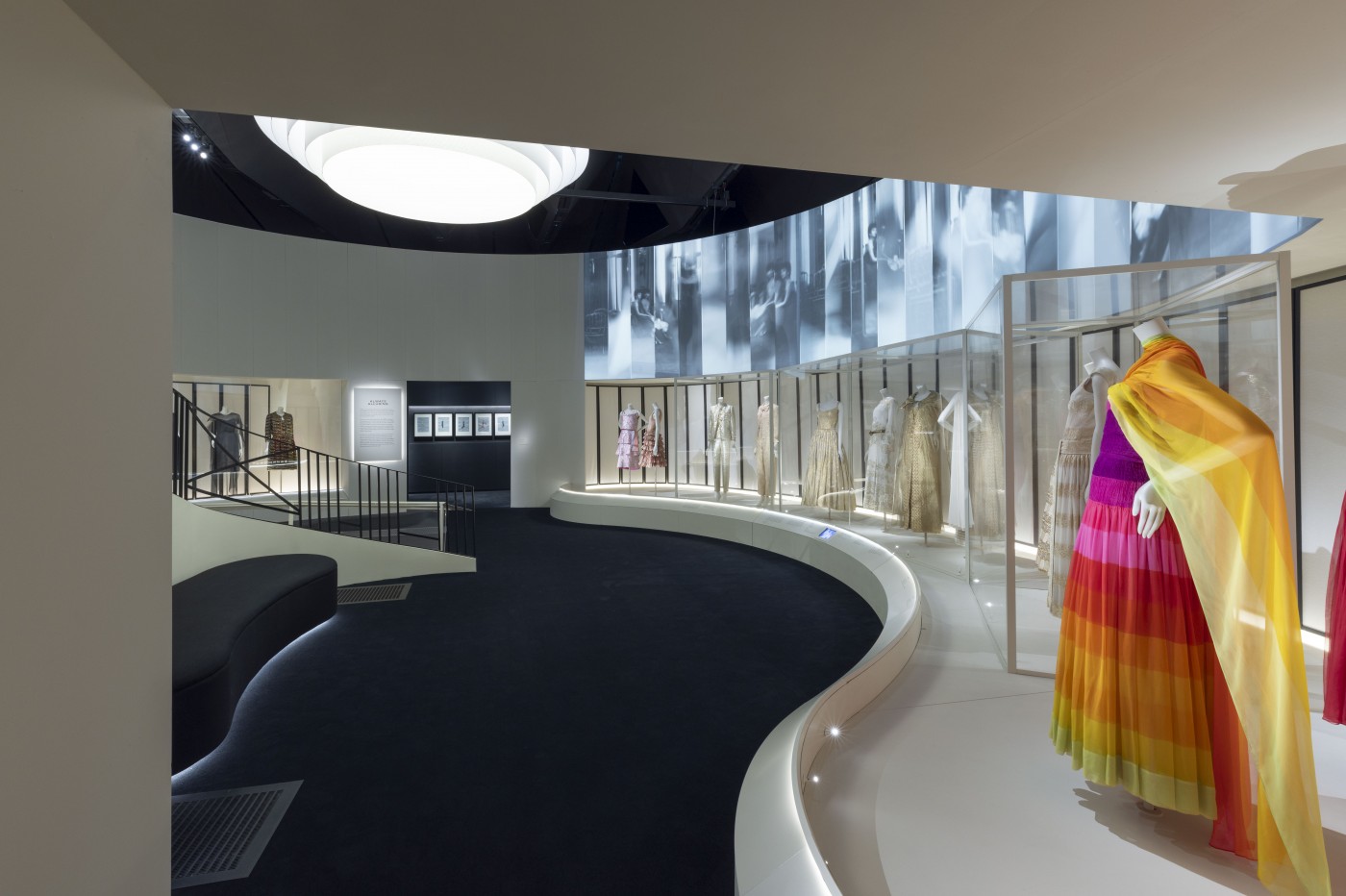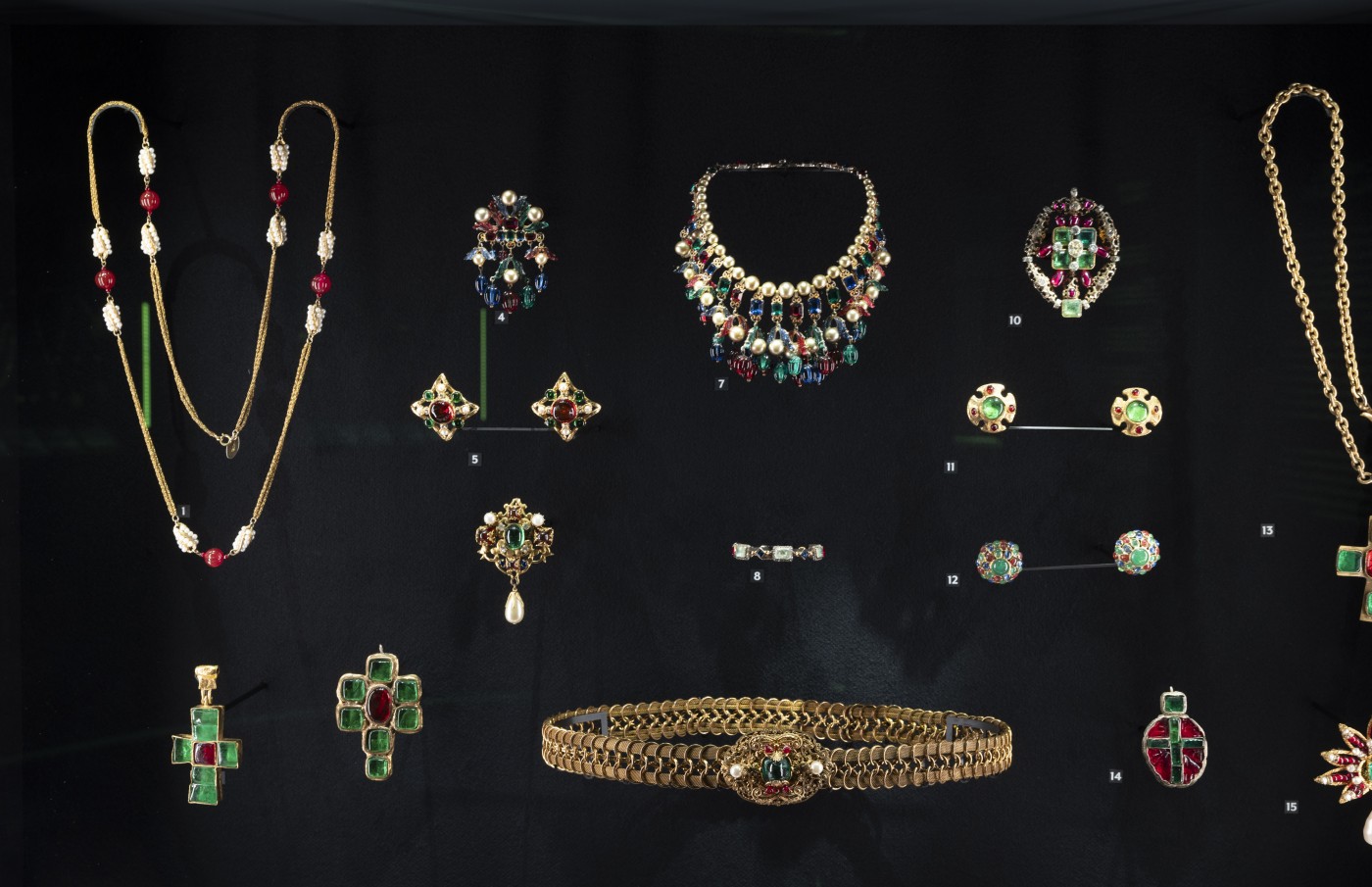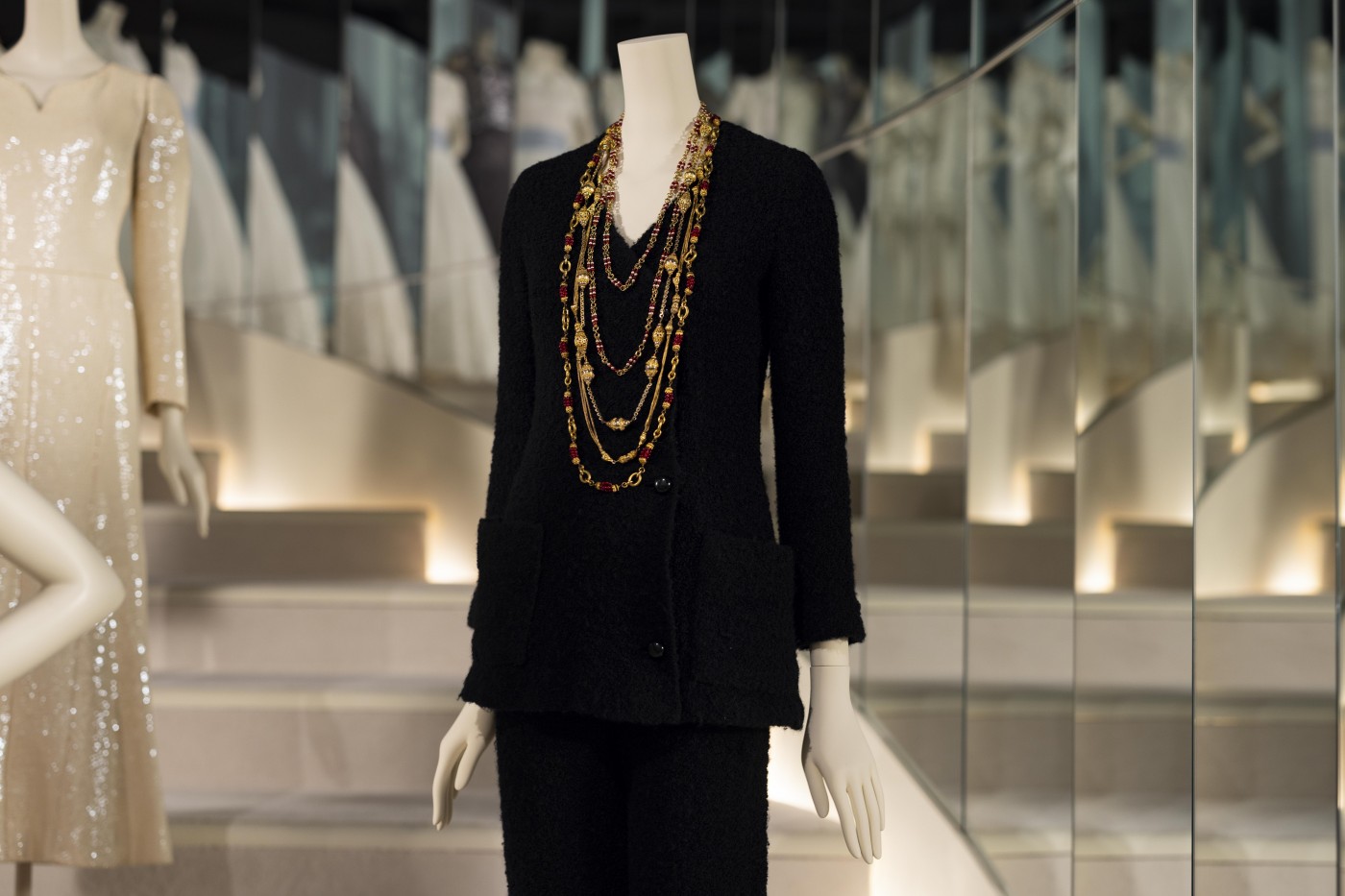- youtube
- bluesky
- Home
- About
- Costume Journal
- Membership
- Conference & Events
- Grants & Awards
- News & Social
In this week’s blog, Costume Society News Editor Babette Radclyffe-Thomas reviews the V&A Museum’s blockbuster fashion exhibition Gabrielle Chanel Fashion Manifesto.
The UK’s first exhibition dedicated to the work and life of legendary fashion designer Gabrielle ‘Coco’ Chanel opened to the general public yesterday featuring over 200 looks shown together for the first time, as well as perfumes, jewellery and accessories. The Costume Society attended the preview and heard about the London staging from the V&A’s curatorial team.
The exhibition charts Chanel’s career and modernist elegant design approach, from the opening of her first millinery boutique in Paris in 1910 to the showing of her final collection in 1971. The establishment of the House of Chanel is central to the exhibition, which shows pieces from the V&A’s own extensive collections, looks from museum collections globally from Paris to the USA and the Patrimoine de Chanel, the brand’s own heritage collections.
The exhibition was first presented in Paris where it was curated by Palais Galleria, Fashion Museum of the City of Paris, Paris Musées curators Miren Arzalluz and Véronique Belloir. The V&A’s interpretation is the fourth iteration of the exhibition, and Arzulluz and Belloir have worked in partnership with the V&A’s curatorial team who include Oriole Cullen to re-imagine the exhibition with the support of the Chanel brand. In this London staging there are over 100 new objects including 60 new looks on show.
“Gabrielle Chanel devoted her long life to creating perfecting and promoting a new kind of elegance based on freedom of movement, a natural and casual pose, a subtle elegance that shuns all extravagances, a timeless style for a new kind of woman. That was her fashion manifesto and legacy that has never gone out of style,” Director of the Palais Galliera, Miren Arzalluz said.
“The exhibition was conceived of as very much looking at her design work. The show looks at the 60 year career that she had, focusing through her clothing,” Oriole Cullen, Head of Modern Textiles and Fashion at the V&A, added in a recent curatorial talk.
Gabrielle Chanel Fashion Manifesto is displayed across ten rooms that highlight how Chanel transformed fashion and style for the modern woman. The exhibition opens with the Towards a New Elegance section which showcases one of the earliest surviving Chanel garments from 1916, the Marinière Blouse, a streamlined and minimalist fine-gauge silk jersey blouse demonstrating her groundbreaking design approach for womenswear by introducing jersey as outerwear. There is also one of her early hat designs from 1917.
Next, the Emergence of Style details the couturière’s approach to understated designs, clean lines and highlights her iconic little black dress. Here Chanel’s use of embroidery and textile designs are examined and showcased against metallic backdrops. A notable section explores Chanel’s British inspirations such as her use of tweed, a textile factory in Huddersfield, the short-lived British Chanel Ltd of 1932-33 and partnerships with British textile firms. The only textile designs that Chanel registered in Britain are on show, alongside a handbag in the matching textile. There are four dresses on loan here from Derby Museums and there are also original costumes designed by Chanel for the Ballets Russes’ production of Le Train Bleu in 1924, which apparently were difficult for dancer Lydia Sokolova to dance in and her fellow principal.
The following room explores The Invisible Accessory, the world’s best-selling fragrance, Chanel No5 as well as Chanel’s sleek skincare and makeup packaging designs. Here a thank you letter written by Queen Elizabeth II in 1955 to Frederick Boy Browning is shown, detailing her gratitude for his recent gift of the iconic scent in which she states “I'm already using it and I hope smelling all the better for it.”
Next, a room designed to imitate Chanel’s South of France villa opens to explore eveningwear. This includes her first iterations of trousers for evening wear, as well as her first and only collection of fine jewellery from 1932, and a sequined trouser suit owned and worn by famed fashion magazine Editor Diana Vreeland. The outbreak of war in 1939 is detailed in the Closing the House section, which shows an interesting selection of documents which add more detail to what we know about Chanel’s wartime activities outside fashion.
Next, visitors enter a spectacular room equipped with double-tiered glass display cases showcasing over 50 variations of the iconic tweed Chanel suit, celebrating Chanel’s post-war contribution to fashion which she made after returning to the industry she loved, aged 71. The double-tiered display also allows visitors to see the weighted hems and contrasts between matching linings. The looks range in colour schemes, silhouettes and details and include pieces worn by style icons such as Hollywood star Lauren Bacall.
The Chanel Codes section showcases her 2.55 handbag design and two-tone slingback shoes, exploring Chanel’s approach to accessories in completing the look, before a section of Chanel eveningwear from the late 1950s onwards. Luxurious decorative fabrics such as gold and silver lamés are used to reimagine her signature suits and here the backdrop is designed to mimic the Coromandel screens that lined her own living room. Costume jewellery is shown such as designs made by the House of Gripoix including early camellia designs made out of gilt metal and multi-coloured glass paste.
The exhibition finalé is striking as visitors enter a recreation of Chanel’s famous mirrored staircase from the couture house on rue Cambon. A selection of garments is displayed as a cascade down the staircase, alongside a few surprisingly bright and colourful Chanel dresses. According to Cullen “In this section we are trying to underline that right up until her final collection of spring/ summer in 1971, Gabrielle Chanel reinterpreted, updated and perfected her rules and principles continuously refining her quintessential style.”
Gabrielle Chanel Fashion Manifesto is open until till 25 February 2024, with tickets said to be sold out until at least December.
Image gallery

Gabrielle Chanel. Fashion Manifesto at the V&A (c) Victoria and Albert Museum, London

Gabrielle Chanel. Fashion Manifesto at the V&A (c) Victoria and Albert Museum, London

Gabrielle Chanel. Fashion Manifesto at the V&A (c) Victoria and Albert Museum, London

Gabrielle Chanel. Fashion Manifesto at the V&A (c) Victoria and Albert Museum, London